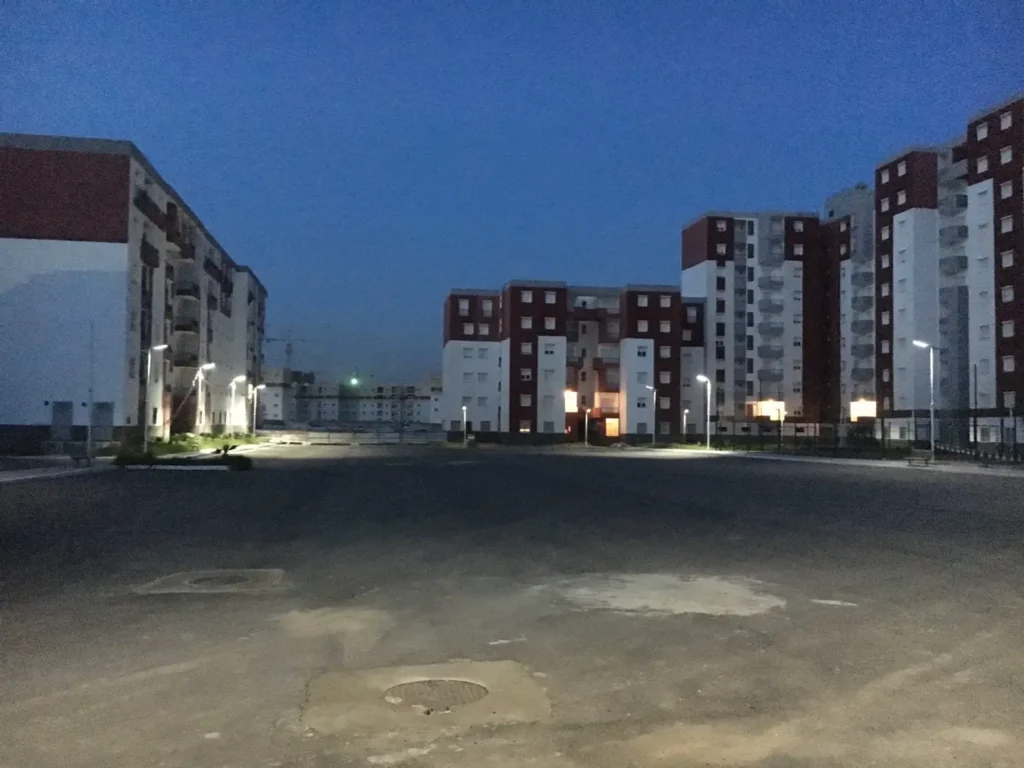Abstract:
This paper explores how a prominent urban square in Algeria effectively addressed the issue of inadequate nighttime lighting by deploying Sresky Atlas series integrated solar streetlights. This initiative not only enhanced the safety and visual appeal of the public space but also exemplified a forward-thinking approach to sustainable development and smart city construction. The Atlas series products used in the project feature exceptional performance, including a luminous efficacy of up to 230 lm/W, advanced ALS2.4 core technology, and the TCS intelligent temperature control system, ensuring stable year-round lighting under various climatic conditions.
1. Project Background and Needs Analysis
A city square in Algeria serves as a vital public space for daily leisure and gatherings for residents of surrounding communities, bordered by multi-story residential and commercial buildings. However, the square’s lighting system faced longstanding challenges:
-
Insufficient lighting and safety concerns: After dark, several areas remained poorly lit, creating blind spots. This not only hindered residents’ nighttime activities but also posed safety risks.
-
High operational costs: Traditional streetlights rely on the municipal power grid, leading to substantial electricity costs and frequent maintenance, which run counter to the city’s sustainability goals.
-
Energy consumption and environmental pressure: As the world shifts toward energy conservation and emissions reduction, fossil-fuel-powered lighting contributes significantly to the city’s carbon footprint.
-
Power supply instability: Certain areas face grid reliability issues, undermining consistent lighting throughout the night.
In response, the project team clearly defined the need for a reliable, efficient, low-maintenance, and energy-saving lighting solution to improve the square’s overall quality and ensure a safe, comfortable, and eco-friendly nighttime environment.
2. Technical Solution Design: Technical Compatibility of the Sresky Atlas Series
Following a careful evaluation of various options, the project selected the Sresky Atlas series solar streetlights. These integrated, technology-rich products aligned perfectly with the project’s requirements.
-
Exceptional lighting performance:
Given the square’s open layout, the SSL-310A model with a brightness of up to 10,000 lumens was selected. Its professional Type II optical design provides wide and uniform light coverage, eliminating dark zones. With LED luminous efficacy up to 230 lm/W and a 5700 K color temperature, the light output is crisp and natural, faithfully rendering nighttime colors. -
All-weather reliability:
Some regions in Algeria experience extended rainy seasons. Sresky’s proprietary ALS2.4 (Adaptive Lighting System) technology plays a vital role by intelligently adjusting light brightness, ensuring over 10 days of continuous operation in low-sunlight conditions—solving a common challenge in the solar lighting industry. -
Intelligent energy management:
-
PIR smart sensing: Each unit includes a 120° wide-angle PIR sensor with an 8-meter detection range. During low-traffic hours, brightness drops to 30%. When motion is detected, it instantly increases to 100%, providing light on demand and saving energy.
-
Multiple lighting modes: The system offers three preset modes (e.g., M1: 30% + PIR until dawn; M2: 5h at 100% + 5h at 25% + 70% until dawn; M3: 70% constant brightness until dawn), adaptable to seasonal and time-based foot traffic patterns for precise energy use.
-
-
Extended lifespan and adaptability to extreme environments:
-
TCS intelligent temperature control: This system protects battery performance in extreme heat and cold, extending lifespan.
-
High-quality lithium-ion batteries: Using automotive-grade lithium batteries with up to 2,000 cycles ensures long-term reliability.
-
Durable housing: The lamp body is made from aluminum alloy with IP65/IK08 ratings, offering strong resistance to water, dust, and impacts—ideal for harsh outdoor conditions.
-
3. Project Implementation and Deployment
The integrated design of the Sresky Atlas series streamlined the installation process:
-
Convenient installation: No underground cabling is needed. A concrete base is constructed, the luminaire is fixed to the pole, and the entire unit is lifted and secured. This reduces the construction timeline and minimizes disruption to the square’s environment.
-
Flexible deployment: For the SSL-310A, an installation height of 10 meters and spacing of 32 meters was recommended, providing optimal lighting coverage.
-
Simplified maintenance: Modular component design enables quick replacements on the pole, significantly reducing maintenance time and costs.
4. Project Outcomes and Impact
The project achieved tangible results across social, economic, and environmental dimensions:
-
Social value enhancement:
-
Improved public safety: Bright, even lighting has eliminated dark corners, reducing the risk of crime and increasing residents’ sense of security.
-
Community revitalization: The square has become a popular nighttime destination for walking, socializing, and fitness, enriching community life and cohesion.
-
-
Economic benefits:
-
Zero electricity costs: Entirely solar-powered, the project eliminates ongoing energy expenses.
-
Lower maintenance expenses: Thanks to the product’s durability and user-friendly design, long-term costs are significantly reduced compared to traditional lighting.
-
-
Environmental sustainability:
-
Promotion of green energy: As a high-profile example, the project showcases the vast potential of solar lighting in public infrastructure, helping raise awareness of environmental protection.
-
Conclusion
The Sresky Atlas solar streetlight project in Algeria represents more than a lighting upgrade—it’s a strategic enhancement of public infrastructure through smart, sustainable technology. By addressing key issues of safety, cost, and environmental impact, this project achieves an ideal blend of social, economic, and ecological value. It stands as a model for urban spaces worldwide—especially along the Belt and Road Initiative and in developing countries—as they pursue a future that is smarter, safer, and greener.



